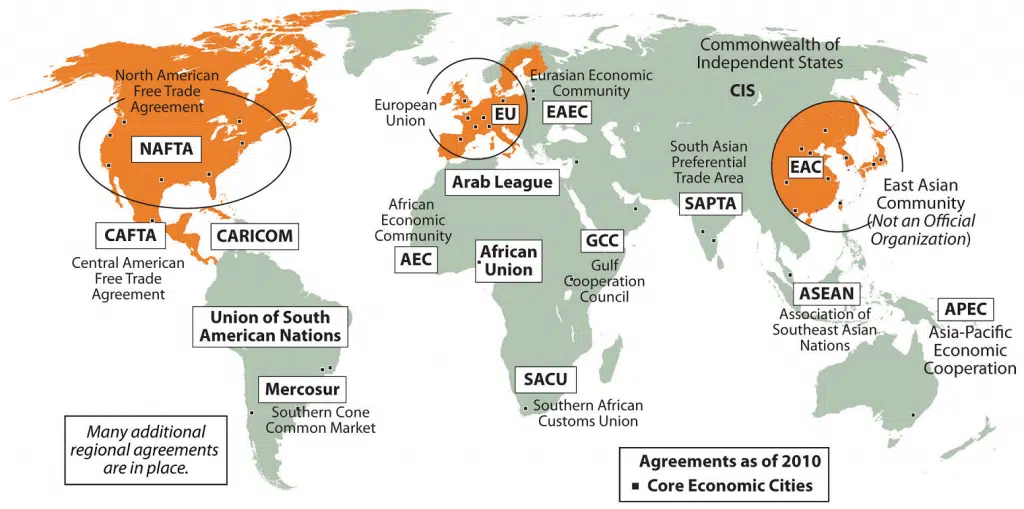- Definition of Trade blocs:
- Formation of Regional Trade Blocks
- The Most Popular Regional Trade Blocs
- The Integration and Effectiveness of Regional Trade Blocs
Definition of Trade blocs: A trade bloc is an association of countries that work together to provide special deals for trading. These regional trade blocs promote trade between countries within the bloc. Before going further, Trade Block, trading bloc, trade bloc will be used interchangeably in this article. Currently, a number of regional trade blocs (or blocks) exist, as well as global trading arrangements.
Formation of Regional Trade Blocs:
These regional trade blocks take three forms.
1. Free trade areas – members in these arrangements agree to lower barriers to trade amongst themselves.
2. Customs unions – these agree a common policy on barriers to external countries. Tariffs, taxes and duties are harmonized amongst members.
3. Common markets – in effect, the members become one trading area. There is free movement of all factors of production. The European Union has economic union as an aim.

The Most Popular Regional Trade Blocs in The World
There are number of popular regional trade blocs). Some are discussed in short including their member countries, for example:
- North American Free Trade Agreement (NAFTA): US, Canada and Mexico, 3 member countries from January 1, 1994.
2. European Free Trade Association (EFTA): Norway, Switzerland, Iceland and Liechtenstein, 4 member countries.
3. European Union (EU): Austria, Germany, Belgium, Bulgaria, Croatia, Republic of Cyprus, Czech Republic, Denmark, Estonia, Finland, France, , Greece, Hungary, Ireland, Italy, Latvia, Lithuania, Luxembourg, Malta, Netherlands, Poland, Portugal, Romania, Slovakia, Slovenia, Spain and Sweden. Formerly, the UK was a member of the association but from 31 January 2020 the UK is no longer an EU member country.
4. Mercosur: Brazil, Argentina, Paraguay and Uruguay (Chile is an associate), 4 member countries.
5. Southern African Development Community (SADC): Angola, Botswana, Comoros, Democratic Republic of Congo, Eswatini, Lesotho, Madagascar, Malawi, Mauritius, Mozambique, Namibia, Seychelles, South Africa, Tanzania, Zambia and Zimbabwe.
6. West African Economic and Monetary Union/Union Economique et Monétaire Ouest Africaine (UEMOA): Ivory Cost, Burkina Faso, Niger, Togo, Senegal, Benin, Mali and Guinea-Bissau.
7. South Asian Association for Regional Co-operation (SAARC): India, Pakistan, Sri Lanka, Bangladesh, the Maldives, Bhutan, Nepal and Afghanistan.
8. Andean Community: Otherwise known as Comunidad Andina (CAN). Four main member countries are-Venezuela, Colombia, Ecuador, Peru and Bolivia. Argentina, Brazil, Paraguay and Uruguay are Associate Members of CAN while Panama, Mexico, and Spain are Observers.
9. Association of Southeast Asian Nations (ASEAN): Brunei, Myanmar, Cambodia, Timor-Leste, Indonesia, Laos, Malaysia, the Philippines, Singapore, Thailand and Vietnam.
Regional trade blocks (or blocs) such as those shown above only extend the benefits of free trade to their members. They may distort, and certainly do not represent, truly global trading patterns. Triad theory describes the international business environment as a limited number of ‘superblocks’.
The Integration and Effectiveness of Regional Trade Blocs
These regional trade blocks differ in their degree of integration and effectiveness.
The EU is the only such block with an elected parliament and a common currency (for some of its members). The USA has a common currency between its individual states.
The ASEAN Free Trade Area has a total population of over 500 million, and a maximum tariff of 5 percent (The Economist, 2 March 2002).
The EU has resisted the scrapping of agricultural subsidies. However, Mercosur is focusing on market
access. This renewed negotiations resulting from the failure of the WTO negotiations at Cancun, and
waning enthusiasm for a Free Trade Area of the Americas. Argentina, a member of Mercosur, is desperate
to expand exports in order to generate growth to overcome its current financial crisis. Mercosur appears
to accept that it is pointless trying to change the EU’s Common Agricultural Policy.
Rather than a globalized world or a federalized world of trade blocks some commentators see economic activity as principally occurring in three main economic blocks (Triads): the USA, the EU and Japan. These do the biggest value of their trade with each other. Triad theory rejects the idea that homogenous products can be developed and sold throughout the world.
Multinationals have to develop their products for the circumstances of each triad. The Triad theory may be out of date. Japan was, in effect, in recession for 20 years from the mid 1980s whilst emerging markets, particularly those of China and India, but also Brazil, are likely to be some of the world’s largest and fastest growing markets. They still have a long way to go before per capita incomes reach the level of the Triad countries. They may form the fourth and fifth trade blocks, or perhaps the triad will be superseded by their faster economic growth.




